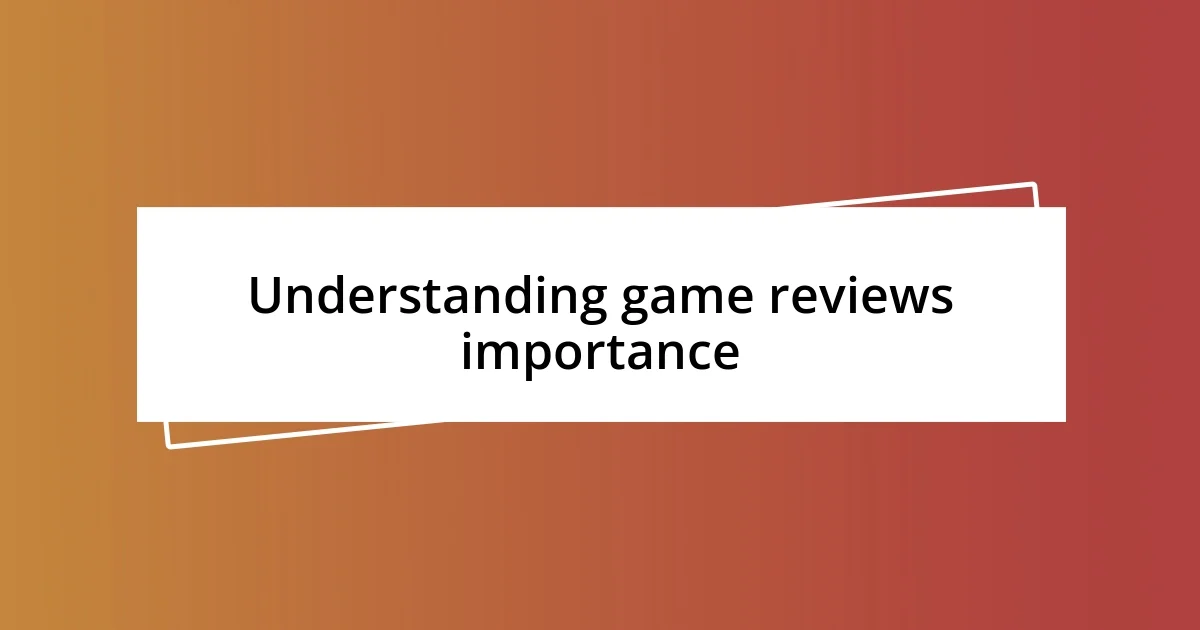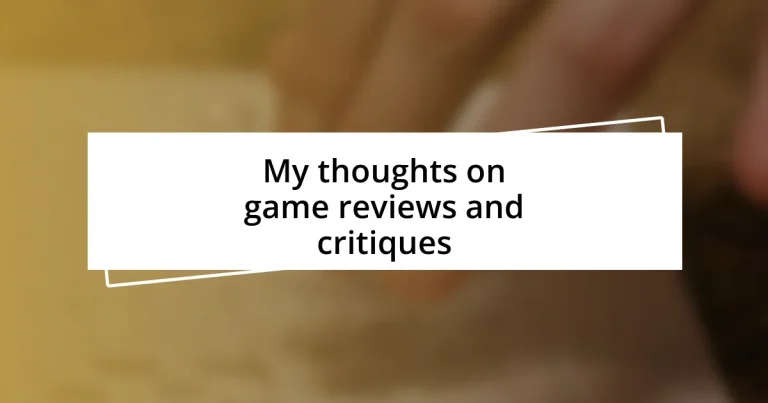Key takeaways:
- Game reviews are vital for shaping player expectations and bridging the gap between developers and gamers, thereby influencing future game development.
- Effective reviews must emphasize clarity, honesty, and personal insights to create relatable and trustworthy critiques.
- Evaluating a critic’s credibility involves understanding their background, engagement with the audience, and consistency in their assessments to gauge their reliability.

Understanding game reviews importance
Game reviews hold immense importance in shaping a player’s experience and expectations. When I read a review, I often find myself nodding along, feeling understood by someone else’s insights. Have you ever noticed how a single poignant line can make you rethink buying a game? That’s the power of well-crafted critiques.
What I love about reviews is their ability to highlight aspects of a game that I might not consider at first glance. For example, I remember diving into a highly praised RPG, only to discover, after reading reviews, how crucial character development was to the overall narrative. It made me appreciate the game on a deeper level. Isn’t it fascinating how a reviewer’s perspective can enrich our own gameplay?
Moreover, reviews act as a bridge between developers and players. They not only reflect our tastes but also provide feedback that can influence future titles. I often wonder: how many developers take to heart the critiques mentioned in reviews? The synergy between gamer feedback and game development is something I deeply value, further emphasizing the crucial role reviews play in the gaming landscape.

Key elements of an effective review
Effective game reviews share a few key elements that make them stand out. Firstly, clarity is paramount. When I read a review, I appreciate it when the reviewer clearly outlines various aspects of the game like graphics, gameplay mechanics, and story. A well-structured review allows me to quickly grasp the strengths and weaknesses without getting lost in excessive jargon. Isn’t it frustrating when you finish reading and still feel a bit confused?
Another essential element is honesty. I recall reading a review of a much-anticipated sequel that, despite its hype, received mixed feedback. The reviewer didn’t shy away from discussing the game’s flaws, which actually made me trust their opinion more. It’s refreshing when critiques don’t just aim to please the developers but genuinely inform players. This authenticity resonates with me deeply, as it reflects a reviewer’s true experience rather than a mere promotional piece.
Finally, personal insights bring a review to life. I’ve noticed that my favorite critiques often include the reviewer’s journey with the game. For instance, a reviewer shared how a certain puzzle took them hours to solve, making me feel less alone in my gaming struggles. It’s these relatable experiences that create a connection and allow me to visualize what playing the game might be like for me.
| Key Element | Description |
|---|---|
| Clarity | Clearly outlines aspects like graphics, gameplay, and story. |
| Honesty | Provides genuine feedback, discussing strengths and weaknesses. |
| Personal Insights | Includes the reviewer’s journey, making the critique relatable. |

Analyzing different review styles
When it comes to analyzing different review styles, I often find myself drawn to those that mix formats—the traditional written review alongside video and audio critiques. There’s something powerful about watching a reviewer’s expressions and hearing their tone while they discuss the game. I remember watching a YouTube critique of a horror game where the reviewer jumped at every scare. It made me laugh but also gave me a visceral understanding of the game’s suspense. That blend of media can create a more vibrant picture of the gaming experience.
Here are some key review styles that resonate with me:
- Written Reviews: These allow for detailed analysis but can sometimes feel a bit dry.
- Video Reviews: I love how they engage with visuals and voice, bringing a game to life.
- Podcasts: These offer a more relaxed exploration, perfect for when I’m on the go.
- Social Media: Quick takes on platforms like Twitter or Instagram can spark my interest in a title instantly.
In my experience, each style has its strengths and brings something unique to the table. The combination of these approaches enriches my understanding and makes the gaming community feel alive.

Balancing subjectivity and objectivity
Finding the right balance between subjectivity and objectivity in game reviews is essential but tricky. I often grapple with the fact that my tastes may not align with another player’s. For instance, while I love immersive storytelling, others might prioritize fast-paced gameplay. This subjectivity can color a review, yet there’s value in maintaining some level of objectivity by valuing aspects like game mechanics and graphics consistently.
I remember the first time I read a review that struck this balance well. The reviewer, while admitting a preference for narrative-driven experiences, also evaluated the gameplay based on universal standards. They highlighted how the mechanics functionally served the story, and that resonated with me. How refreshing it is when a review acknowledges personal bias but still grounds its critique in quantifiable terms!
Ultimately, I believe blending personal experience with objective metrics creates a fuller picture. When reviewers share how a game made them feel while also detailing its technical aspects, it allows for a shared understanding. It’s like having a conversation with a friend who understands your gaming preferences while also providing insightful assessments. Doesn’t that enhance your experience of choosing a game?

Evaluating the credibility of critics
Evaluating the credibility of critics hinges on understanding their background and expertise. I often do a little digging to see what games a reviewer typically covers and their history in the gaming community. For instance, if a critic specializes in indie games, I’ll factor that into how I interpret their thoughts on a blockbuster title. It’s insightful to consider whether they’re approaching a game with familiarity or if they’re branching into new territory.
Another crucial component for me is the reviewer’s engagement with their audience. I find it telling when a critic responds to comments or participates in discussions about their reviews. I remember following a critic who was not only knowledgeable but also humble, often revisiting their previous assessments based on viewer feedback. It built trust and made their insights feel more personal and relatable. Have you ever felt more connected to a critic after they interact with their audience? It can make all the difference.
Furthermore, consistency across reviews is something I pay close attention to; a credible critic shouldn’t swing wildly in their evaluations without reason. If I see someone praising every game regardless of its flaws, I become skeptical. In my experience, a reviewer’s willingness to critique both the highs and lows fosters a more trustworthy reputation. This makes their honest praise or criticism feel more impactful—and honestly, who doesn’t appreciate an unvarnished take when deciding whether to invest time and money into a game?

How to interpret game scores
It’s essential to look beyond the number when interpreting game scores. I remember when I saw a game score of 7 out of 10, which I initially thought was poor, but the review revealed that while the graphics were lackluster, the gameplay was incredibly engaging. This experience taught me that scores can often reflect certain elements rather than an overall quality, urging me to dive deeper into the review itself. Have you ever been surprised by a game you loved that didn’t score exceptionally high?
When I examine game scores, I try to understand the scale used and what different numbers represent. A score of 9 might seem like a masterpiece, but if the reviewer mentions a few significant flaws, it’s worth pondering whether those detract from the overall experience. I’ve often found that reading the accompanying commentary has shaped my perception more than the score alone, revealing how it aligns with my preferences. Have you discovered a hidden gem that didn’t meet critical acclaim at first?
Finally, it’s wise to consider the context surrounding a game’s score. An early-access title might bear a different complexion in reviews than a polished release, and that perspective can shift my expectations. Recently, I played an independent game that earned a solid 8 but was labeled as “ambitious but flawed.” I resonated with that sentiment, which encouraged me to appreciate its uniqueness rather than solely focusing on its shortcomings. In your personal gaming journey, how often do you find yourself drawn to games that defy expectations based on their scores?

Writing your own game critiques
Writing your own game critiques can be an incredibly fulfilling experience. When I started sharing my thoughts on games, I realized that my personal experiences with them really shaped my perspective. For instance, playing a nostalgic classic, like “The Legend of Zelda”, often makes me more forgiving of flaws because of the joy it brings me. Have you ever noticed how your personal history with a genre influences your critiques? It certainly colors mine.
I’ve found that structuring my critiques is just as important as the content itself. Starting with the gameplay, then moving to visuals, and wrapping up with sound and overall experience helps create a clear flow. When I reviewed a challenging platformer last year, I made sure to highlight both the thrilling escapades and the hair-pulling frustration it offered. This arrangement made my points easier to digest, and I truly believe it helps readers grasp my perspective better. What about you—do you have a preferred way of organizing your thoughts when reviewing?
Incorporating personal anecdotes into my critiques also gives them a unique touch. I remember the late nights I spent trying to best a tough boss, feeling that rush of triumph when I finally succeeded. Sharing moments like these makes my insights relatable and adds a deeper layer to my evaluations. By inviting readers into my gaming journey, I encourage them to reflect on their own experiences, enriching our shared appreciation for the medium. Have you ever had a moment in a game that made you reevaluate how you feel about it? Those moments can be game-changers, literally and figuratively.














